As the range of wide angle lenses available for Sony’s fantastic Alpha 7III Mirrorless cameras rapidly expands, the task of narrowing these down to a definitive first choice becomes ever more difficult.
In reality though, the best wide angle lens for the Sony a7III is simply the right wide angle lens for your photography.
So precisely which lens you should go for will in large part depend on your own particular technical needs and shooting style.
Aside from this, though, there are a number of important considerations that anyone considering purchasing a wide angle lens for the a7III would do well to take into account.
And in this guide I will walk you through each of the main points to consider.
First though, let’s take a look at a bunch of the main contenders – covering options for every budget.
As with all other lenses in the G-Master series, the 24mm f/1.4 doesn’t come cheap.
However, it’s actually a lot more competitively priced than you might expect of a lens this good.
Indeed, when the 24mm GM was released, many were skeptical that a 24mm at this price point – and of such discrete dimensions – could possibly deliver the pro-level image quality Sony promised.
Pros
- Supremely sharp
- Almost devoid of optical aberrations
- Fast maximum aperture
Cons
- Premium G-Master pricing
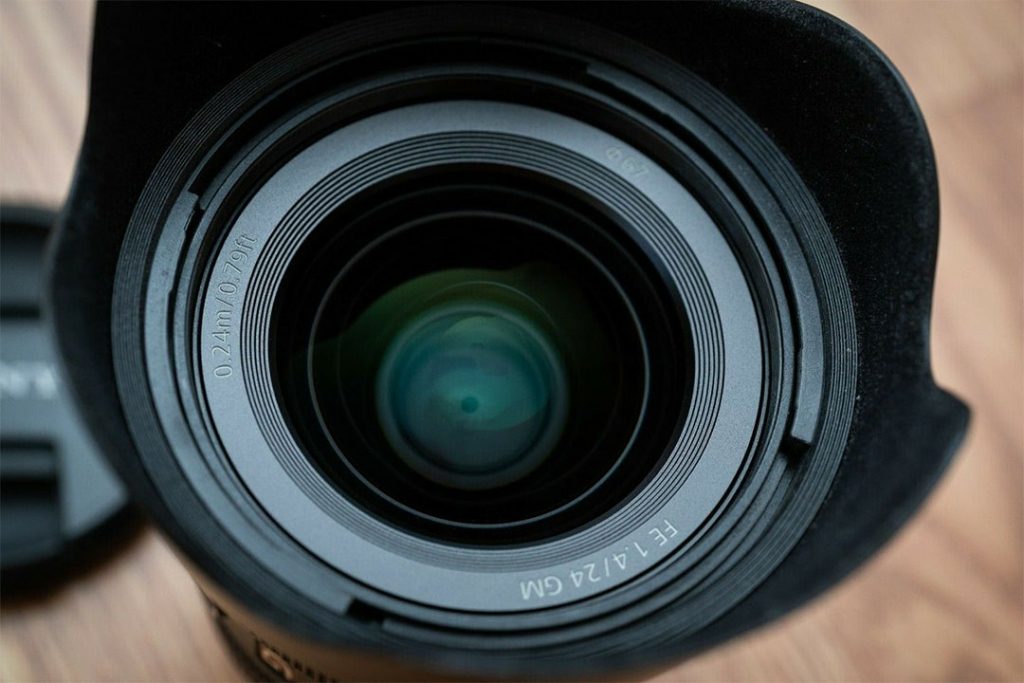
But deliver it does. In fact the 24mm GM produces stunningly sharp photos that maintain optical standards right across the frame and throughout the aperture range.
What’s more, there’s very little in the way of comatic aberration, so when combined with it’s very fast maximum aperture, it’s obvious that this is one of the best lenses currently available for astrophotography.
Of course, with its wide angle of view and impressive optics, the 24mm GM will also appeal to those who shoot landscapes, interiors, action sports, and street photography.
Meanwhile the f/1.4 aperture also makes this a versatile tool for documentary work in low light. Indeed, while the 24mm GM doesn’t boast the extreme angle of view of, say, the Batis 18mm (below), what you gain instead is an extra stop of light-gathering abilities; highly appealing for both night-sky shooters and reportage photographers alike.
All in all, this is a fantastic wide angle lens that offers stunning resolution and image quality, lovely bokeh, and performs beautifully in low light.
It also happens to be very small and lightweight compared to most other lenses of this focal length.
Ultimately then, the only reason you might want to consider other options is purely because of budget. For those who can afford it, though, the 24mm f/1.4 GM is worth every cent of its asking price – and then some.
Covering focal lengths from very wide to extremely wide, Sony’s FE 12-24mm f/4 G lens is an excellent ultra-wide angle zoom.
It will appeal to everyone from landscape and interiors photographers to those shooting action sports and adventure photography.
Pros
- Very wide angle of view
- Fast autofocus
- Exceedingly sharp
Cons
- No image stabilization
- Doesn’t accept filters
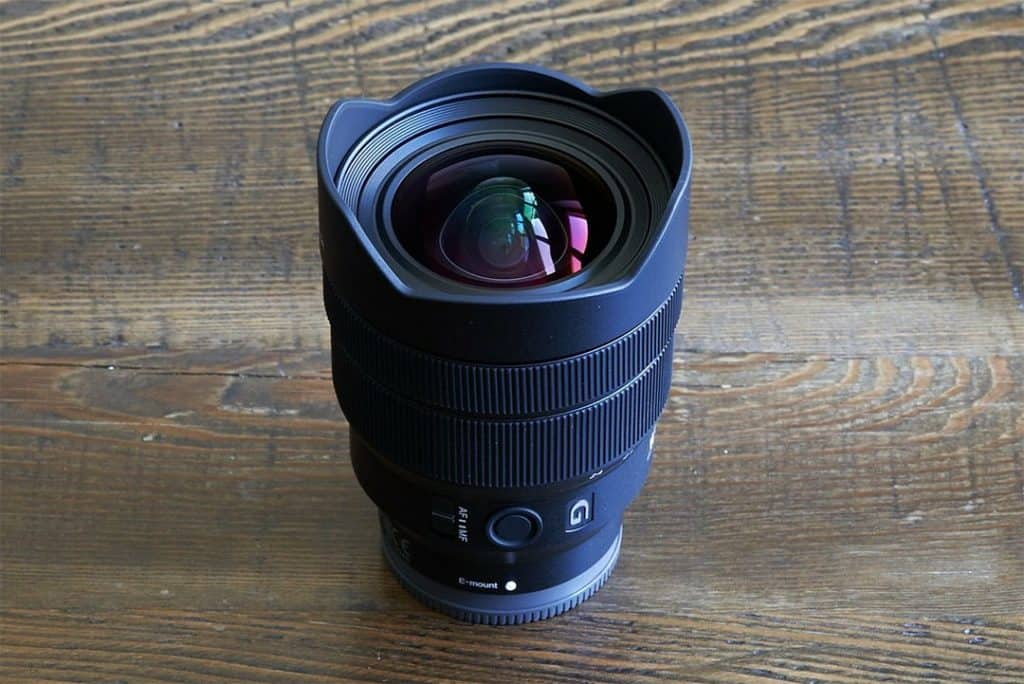
The widest lens currently available for the Sony a7III, the 12-24mm is very sharp across the frame from f/5.6 onward.
However, you should expect to see both noticeable corner-softness and vignetting when shooting at its widest aperture.
Bokeh is never going to be a consideration of much importance when purchasing a lens this wide.
Indeed, with an ultra-wide-angle, even just getting the background out of focus at all will be challenge enough.
And here the task is made more difficult still by the fairly slow maximum aperture of f/4.
But if you do manage to achieve some separation between foreground and background, rest assured that out of focus rendering will be perfectly attractive.
Autofocus works brilliantly (and silently), too. And while the 12-24mm follows the bulk of Sony’s lenses in being of the “focus-by-wire” variety, manual focus action is nonetheless satisfying and precise.
For those seeking an ultra-wide angle lens for the a7III, the 12-24mm offers both a wider and cheaper option than the pricey 16-35mm GM. Of course, the 12-24mm also lacks the G-Master’s faster aperture and pro-level spec.
But as this is a lens that will largely appeal to landscape photographers – and landscape photography rarely calls for a fast maximum aperture – this is unlikely to be of real concern to the majority of potential users.
Be warned, though, that there is one detail that might dissuade a few landscape photographers; the 12-24mm’s (unremovable) lens hood makes it impossible to use the lens with filters of any description.
There’s really not a lot about the Sony 16-35mm f/2.8 GM that is deserving of negative criticism.
At least not where either spec or performance are concerned. Indeed it’s a truly great lens on every front.
But if you detect the slight hint of reservation in this opening paragraph, it’s simply because this unarguably fine piece of glass comes as quite a hefty investment.
Pros
- Beautifully sharp and contrasty
- Relatively fast maximum aperture of f/2.8
- Well-built and fully weather sealed
- Great autofocus
Cons
- Expensive
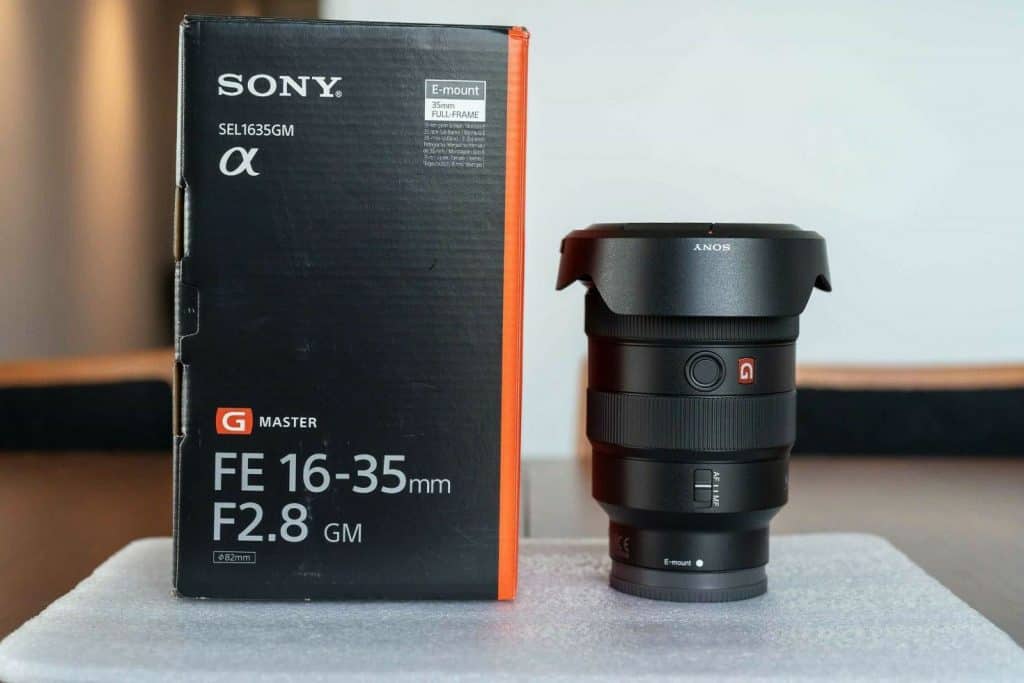
In fact the 16-35mm f/2.8 is considerably more expensive than the FE 12-24mm f/4 (above), despite offering a shorter angle of view.
Of course, 12-24mm is a pretty extreme range, and will be of only limited use to most photographers.
So for those in need of a lens wide enough to cover most landscape and interior scenarios, yet also fast enough to be of use in lower-light situations, the 16-35mm f/2.8 GM can make for a highly appealing alternative to both the 12-24mm and Sony’s Tessar T* 16-35mm f/4. Just expect to pay handsomely for it.
The 16-35mm’s advantages don’t end with low light capabilities, however; in addition to a faster maximum aperture, you also get both superior optics and sturdier build, not to mention the ability to use filters (something that’s notably missing from the 12-24mm).
Bokeh, too, is far superior here; owing to a full 11 aperture blades. While bokeh isn’t the most important of considerations on a wide angle lens, in this case the faster maximum aperture means that a degree of background blur is certainly achievable.
Overall, this is truly a lovely lens. However, if we are forced to nitpick, it should be mentioned that the 16-35mm f/2.8 lacks built in image stabilization.
But as your Sony a7III comes with stabilization all of its own, really this is a bit of a non-problem.
In short, if you can stretch to the asking price, there’s really very little reason not to go with the 16.35mm GM.
Tamron’s 17-28mm f/2.8 wide-angle zoom offers great functionality and beautiful optical performance at a highly competitive price.
Indeed, those drooling over the Sony 16-35 f/2.8 GM (above), but feeling decidedly queasy at the prospect of stumping up all that cash, should give Tamron’s offering very serious consideration.
Objectively the G-Master might be the better lens, but certainly not over two-times better!
Yet that’s the difference in price here.
Pros
- Competitively priced
- Great optics
- Fast, silent AF
- Well-built and fully weather sealed
Cons
- No image stablization

Let’s be totally clear: the GM is an almost flawless bit of optical engineering.
But it must be said that the Tamron doesn’t trail far behind. For a start, it comes with more lens elements than the Sony (13 to the GM’s 11), resulting in very impressive bokeh (however be warned that some “onion rings” are detectable).
Indeed, optical performance is fantastic; producing images that are sharp edge to edge, even when shooting wide open.
It’s also lighter and more compact than the GM, and yet offers the same relatively fast constant maximum aperture of f/2.8.
What’s more, the Tamron is sturdily built and fully weather sealed (although precisely how it measures up to the GM on this front is not something we can realistically afford to test).
When it comes down to it then, the only major difference between the Tamron and the G-Master is that the latter offers a wider zoom range.
For some photographers that will be the deal breaker. For others – who may already own, say, the 28-70mm kit lens and can live without the extra 1mm of reach at the wider end of the scale – this will be of no concern whatsoever.
True, you don’t get image stabilization with this lens. But as this is a guide to wide angle lenses for the Sony a7III, it seems safe to assume that you are already well covered for stabilization.
Seen in this light, Tamron’s offering is a very serious contender for the title of best wide angle lens for the a7III – at any price point.
At the very least, anyone considering the GM should think twice before putting down their money.
The Batis 18mm’s primary appeal simply lies in the incredible image quality and detail it is capable of producing.
Indeed, photos shot with this lens are supremely sharp, even when the lens is used at its widest aperture setting.
Pros
- Incredibly sharp
- Fast maximum aperture
- Weather sealed
Cons
- Big
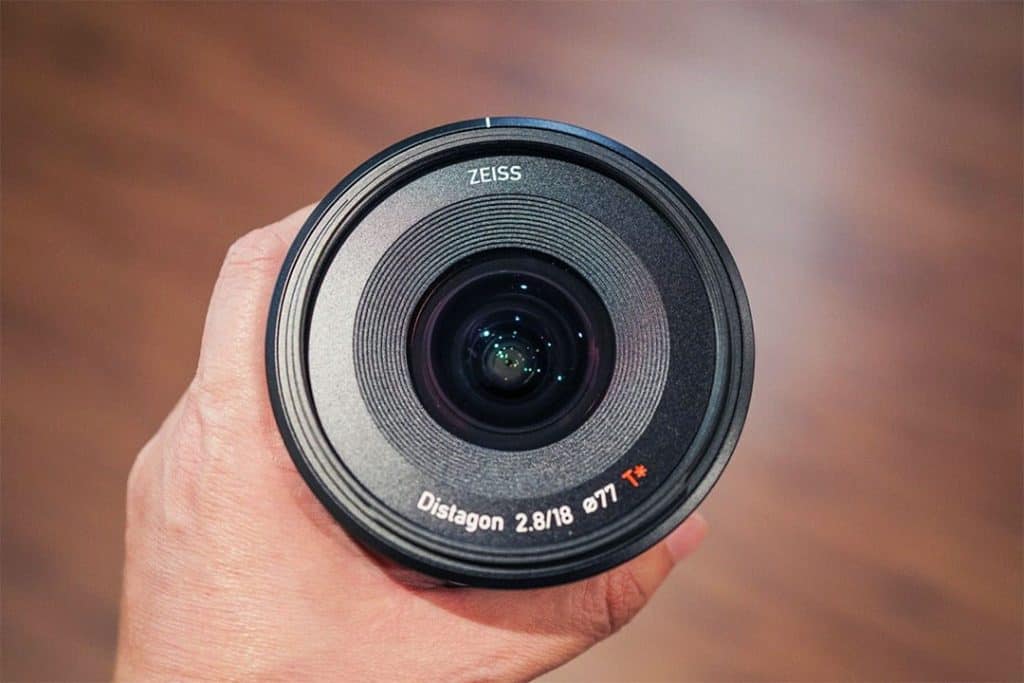
In itself, though, this aperture is also something of a selling point; as most lenses of such a wide focal length tend not possess overly impressive light-gathering abilities.
Beyond being an excellent choice of lens for landscape photography, then, the Batis 18mm f/2.8 is also particularly well suited to night-sky photography – where the triad of a fast maximum aperture, exemplary image quality, and a wide angle of view make for a truly winning combination.
An ultra-wide angle lens of this kind will never be anybody’s tool of choice for creating a shallow depth of field. However, some degree of separation is achievable here when shooting up close and wide open.
With that said, though, the Batis’s bokeh really isn’t anything to get too excited about anyway.
Just as well, then, that the majority of images you shoot with this lens will likely be sharply focused from foreground to infinity – meaning that you simply won’t notice any bokeh anyway.
While few photographers will complain about the relatively fast maximum aperture of f/2.8, the extra optics required to achieve this makes for a strikingly large lens.
Thankfully, though, Zeiss has managed to keep weight rather more under control than bulk.
Consequently, few people will find it too much of a chore to have this thing hanging around their neck all day long.
The lens is rather minimal in design, boasting a barrel that is all but featureless.
The one noticeable exception being an LCD focusing scale for use with its (focus-by-wire) “manual” focus ring. Meanwhile autofocus is so beautifully fast and accurate that few people will be tempted to reach for manual control anyway.
While the lens lacks built-in image stabilization, your Alpha 7III does not. In any case, stabilization isn’t really necessary on such a short focal length. Weather sealing, however, is a very welcome addition.
Multicoated and featuring 12 elements in 8 groups, the 35mm f/1.4’s optical performance is nothing less than superb.
In practice this means stunning sharpness and excellent contrast – not to mention very smooth and natural-looking bokeh due to the 9 rounded aperture blades.
Pros
- Great sharpness and contrast
- Fast maximum aperture
- Smooth bokeh
Cons
- Big and heavy
- Expensive
- Inconsistent quality control
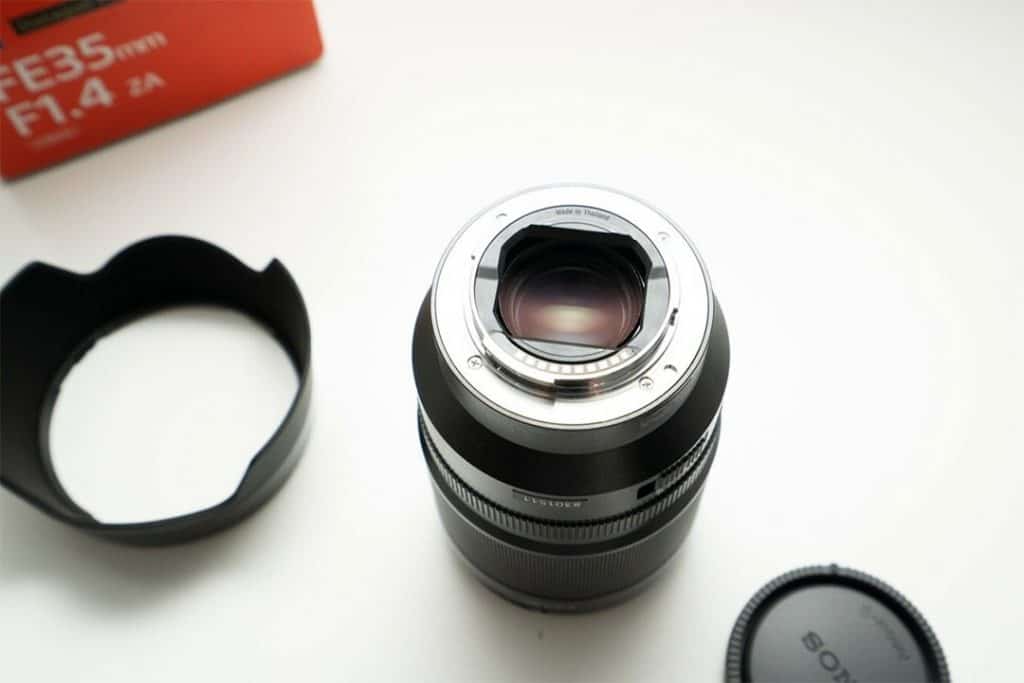
Like the majority of Sony’s E-mount offering, “manual” focus on this lens works via a focus-by-wire mechanism, resulting in non-linear manual focus action (boo!).
With that said though, the 35mm f/1.4 does come with a physical aperture ring (indeed, it was one of the first Sony E lenses to do so), making at least this side of operation a great deal more convenient and pleasurable than many alternatives.
Of course these Sony “Zeiss” lenses are not actually made in Germany by Zeiss, but instead under-license in Southeast Asia by Sony.
Nonetheless, anyone who’s spent any amount of time with any of the products in this line will be well aware that Zeiss doesn’t just go around handing out licenses to any fly-by-night operation.
With that said, while we might imagine that quality control would be very stringently enforced, this lens is known to vary somewhat in performance between samples.
When it works, it works brilliantly.
But if you are unlucky enough to end up with a dud (in practice that means decentering issues) be sure to send it back for a fully-functioning replacement.
Arguably 28mm is a much more convenient focal length for daily use than more extreme wide angles.
And when it comes in such a small and lightweight package as this, but with a nice fast maximum aperture of f/2, the result is a supremely useful lens.
Great for landscapes; particularly well suited to weddings, events, documentary, and street photography; and passable for astrophotography, the Sony FE 28mm f/2 is simply a very dependable and hardworking prime lens that all Sony a7III users should consider keeping in their bag.
Pros
- Fast maximum aperture
- Small and lightweight
- Great price
Cons
- No image stabilization
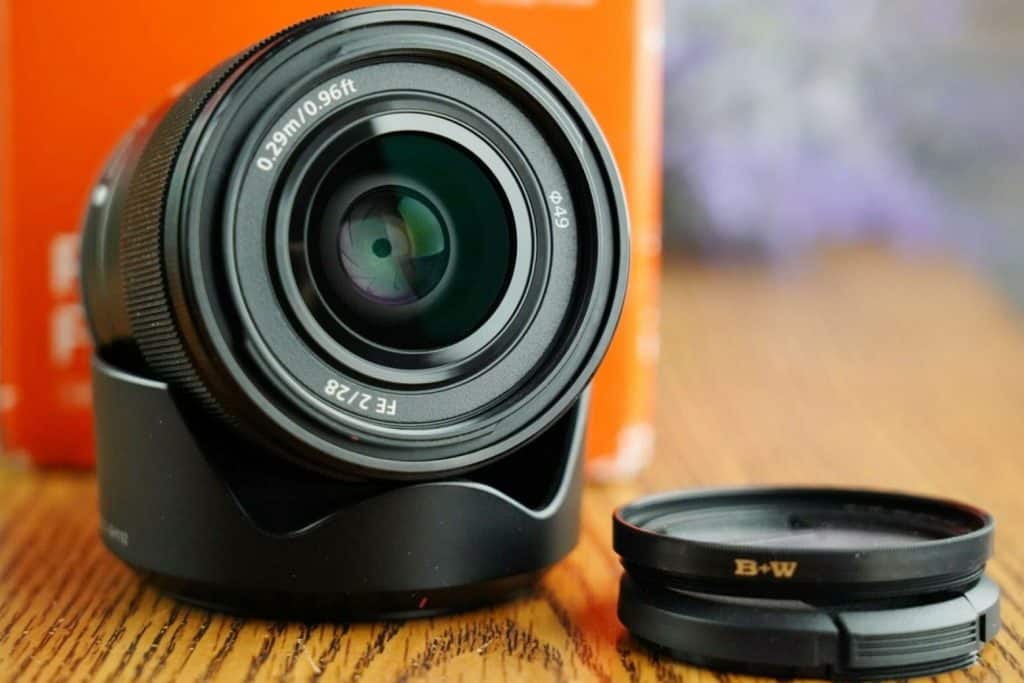
The FE 28mm displays excellent center sharpness at f/2, but with some loss of clarity at the edges.
Stopping down even slightly fixes the corner problem though, and center sharpness becomes better still. While there is some color fringing at wider apertures, you’ll need to look hard to notice it.
Despite the wide angle of view, nice enough bokeh can be achieved when shooting up close; even if this tends to be a little on the busy side.
Manual focusing is smooth and well-dampened. Although – as is customary with Sony’s lenses – it uses the focus-by-wire system. Meaning that it will never offer quite the same degree of manual control as a lens that focuses by truly mechanical means.
There’s little to complain about on the autofocus front, however, as here performance is both snappy and silent.
How To Pick The Right Wide Angle Lens For Your A7III
Maximum Aperture
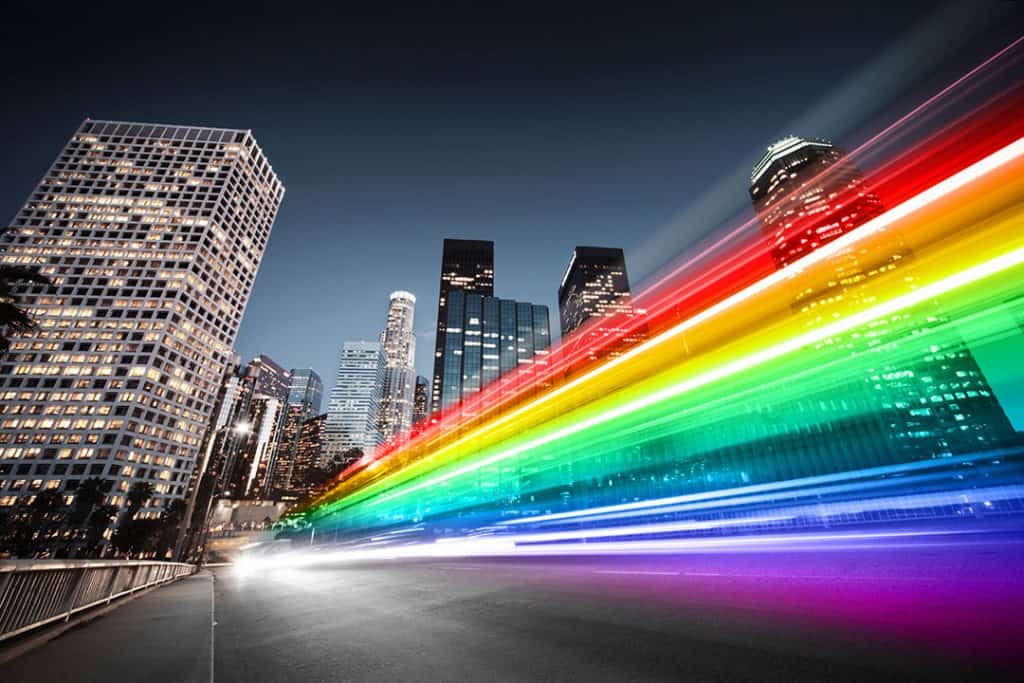
As a general rule, the faster the maximum aperture a lens offers, the higher the asking price.
For some photographers, this extra investment will be money well-spent. Perhaps even a necessity.
For others, though, it will be an unjustifiable and entirely avoidable expense.
Which kind of photographer are you?
Need to shoot handheld in low-lighting conditions? Want to photograph the Milky Way or other nightscapes?
Often shoot fast-moving subjects and don’t want to see any motion-blur in your images?
In all of these cases a fast maximum aperture will be essential.
Consequently photographers working in genres ranging from documentary to portraiture and from astrophotography to sports – and a whole lot else besides – tend to purchase the fastest lenses they can afford.
And for those trying to achieve a shallow depth-of-field, fast maximum aperture takes on a whole extra degree of importance when considering wide angle lenses.
This is because the wider the focal length, the more the image is likely to be in focus from foreground to background.
Even at relatively small apertures. So a diaphragm setting that might blow the background out to a pleasing blur on a 50mm standard lens could leave much of the background relatively sharp and recognizable when used on, say, a 20mm lens.
While an extra stop or two of aperture opening will go a long way towards compensating for this effect, be aware that even the fastest wide angle lens is never going to be able match the extremely shallow depth-of-field typically produced by a telephoto lens at even a relatively slow aperture setting.
However, there are also several genres of photography where the fastest aperture settings of even a relatively slow lens are unlikely to see much use.
The most notable of these being landscape photography.
This is because the shallow depth-of-field produced by a fast aperture setting is entirely inappropriate for shooting landscapes.
Here a deep depth-of-field that sharply renders both background and foreground in splendid detail will be much more desirable.
Clearly then, if you intend to shoot almost exclusively at f-stops of f/11 or slower, spending extra money on a lens that goes to f/1.4 would make no sense at all.
Especially if you can buy a perfectly good lens with a maximum aperture of, say, f/4 or f/5.6 for a fraction of the price – as indeed is often the case.
Bokeh on a Wide Angle lens?
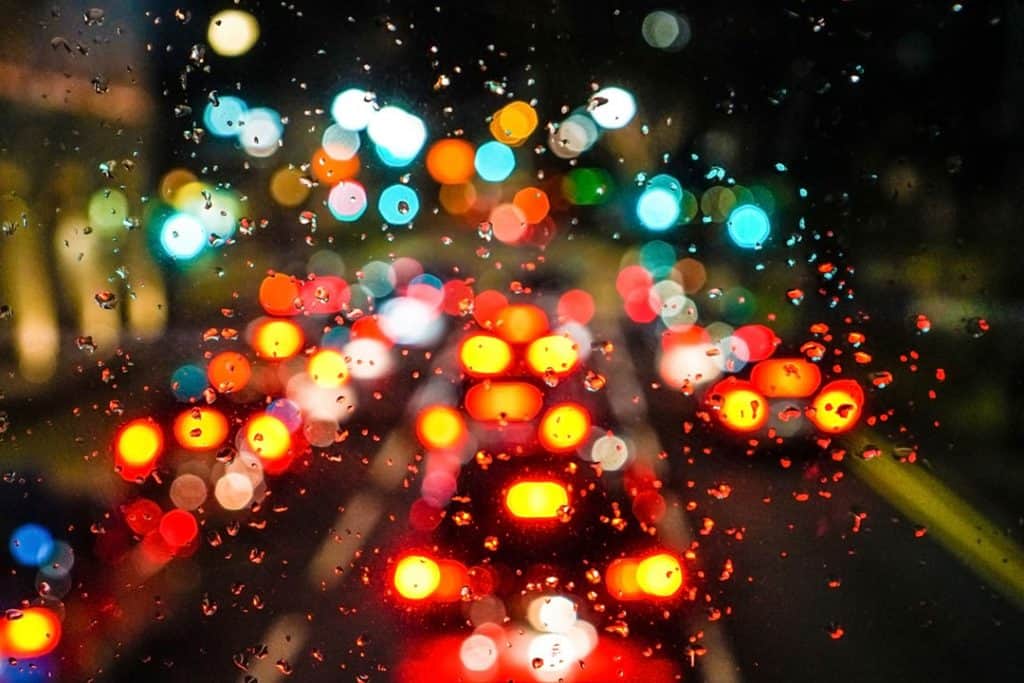
The word bokeh refers to the quality of out-of-focus areas of an image.
This not only means the degree to which a background is blurred, but how it is blurred.
Some lenses render blurred areas smoothly. Others produce a blur-effect that is much busier, resulting in backgrounds that distract from the subject. For obvious reasons, a lens that produces smooth bokeh is usually more highly prized than one that does not.
As we’ve just seen though, wide angle lenses tend to struggle to blur the background at all.
This being the case, bokeh is a lot less important when considering purchasing a wide angle lens than it would be with, say, a “nifty-fifty” or a portrait lens.
The only exceptions being moderate wide angle lenses – such as a 28 or 35mm lens – with very fast maximum apertures.
As here some background blur will likely be achievable; particularly when photographing a subject up close.
Sharpness
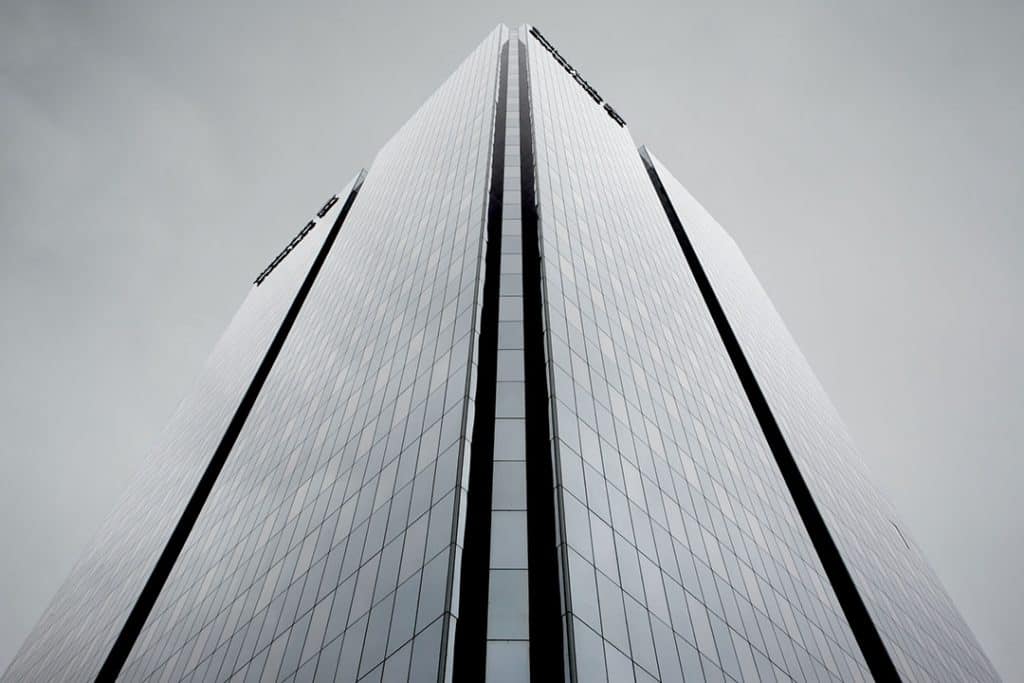
Most modern lenses – and certainly all those available for the Sony a7III – produce sharp images.
Or rather, images that are nicely sharp in the center of the frame. Corner sharpness is an entirely different matter, however, and is often the factor that sorts the good from the bad.
All lenses tend to perform their best in terms of sharpness once stopped down a few clicks from maximum aperture. This is to be expected.
What can vary greatly is the degree to which sharpness deteriorates as you move away from a lens’s peak aperture setting.
Some lenses maintain a level of image sharpness not far removed from peak performance right through to their widest setting; while others become almost unusable if set to maximum aperture.
In short, in order to understand whether a particular lens is optically sound or not, it’s not enough merely to look at a few images that were produced with it, checking for sharpness.
Instead, if you are to make a serious evaluation of a lens’s optical performance, you will need to see examples shot at a variety of different aperture settings, and to check for fall-off in resolution towards the edges of the frame – particularly at faster apertures.
Focal Length
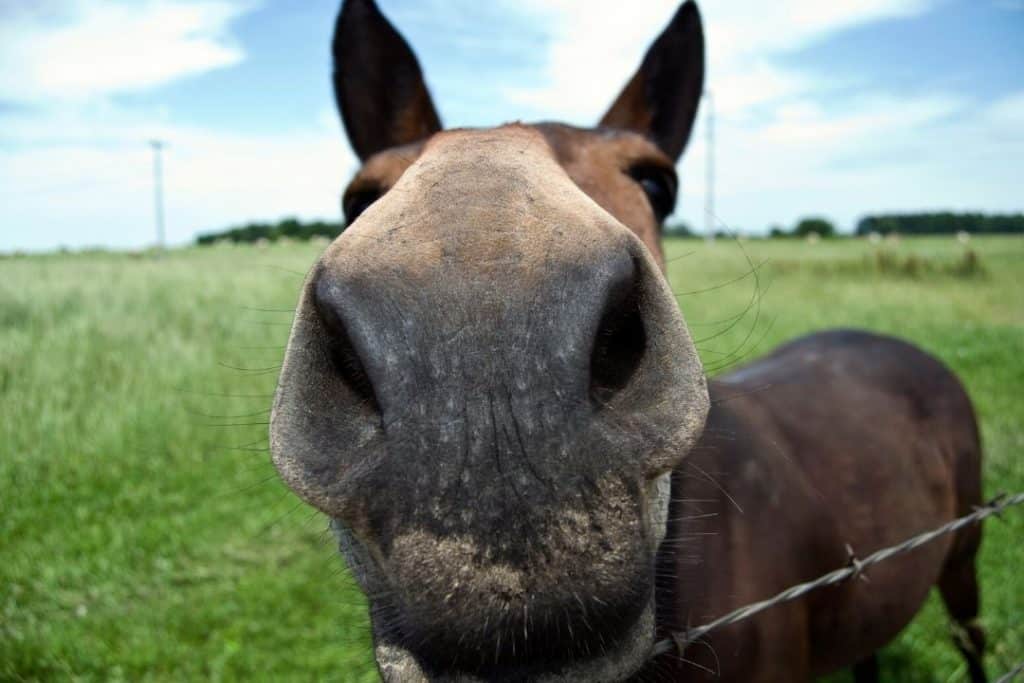
Just because this is a guide to wide angle lenses doesn’t mean that the matter of focal length can just be taken for granted.
Indeed, the umbrella term “wide angle” actually covers rather a broad range of focal lengths; from the decidedly reserved 35mm lens through to a full-on fish-eye that will make anything it’s pointed at look like a poster for a Fillmore “love-in” circa 1967.
And, as with any other kind of tool, each focal length is much better suited to certain tasks than it is to others.
However, when it comes to wide angle lenses, noob photographers and chronic GAS (gear acquisition syndrom) sufferers often equate wider with better.
In this parallel world of photography, a 16mm lens is an inherently far sexier object than a humdrum 35mm.
To be sure, ultra-wide angle lenses have their legitimate uses, and for certain professionals working in specialized areas of photography (real estate being just one obvious example) they are essential tools.
However, many who earn their living from photography – and indeed many who do not – look upon such lenses as somewhat gimmicky. With their highly distorted and dominant perspective, it’s easy to see why; often the resulting photo becomes more about the lens than about either the subject or the skill of the photographer.
Conversely, a more moderate wide angle lens will still permit you to include a broad swathe of scene in the frame, but without either making the subject appear tiny or producing a heavily distorted perspective.
As with any creative pursuit, though, photography is a highly personal endeavor.
And if head-spinning, stomach-churning, horizon-bending perspective is your thing, don’t let anyone tell you otherwise – least of all some random stranger on the internet.
Just keep in mind, though that once the novelty of the visual effect produced by an extreme wide angle lens has worn off, you may well find yourself wishing you’d gone for something a little closer to a normal human perspective; such as a 35mm lens for example.
Image Stabilization (The Sony A7III already has in-body IS)
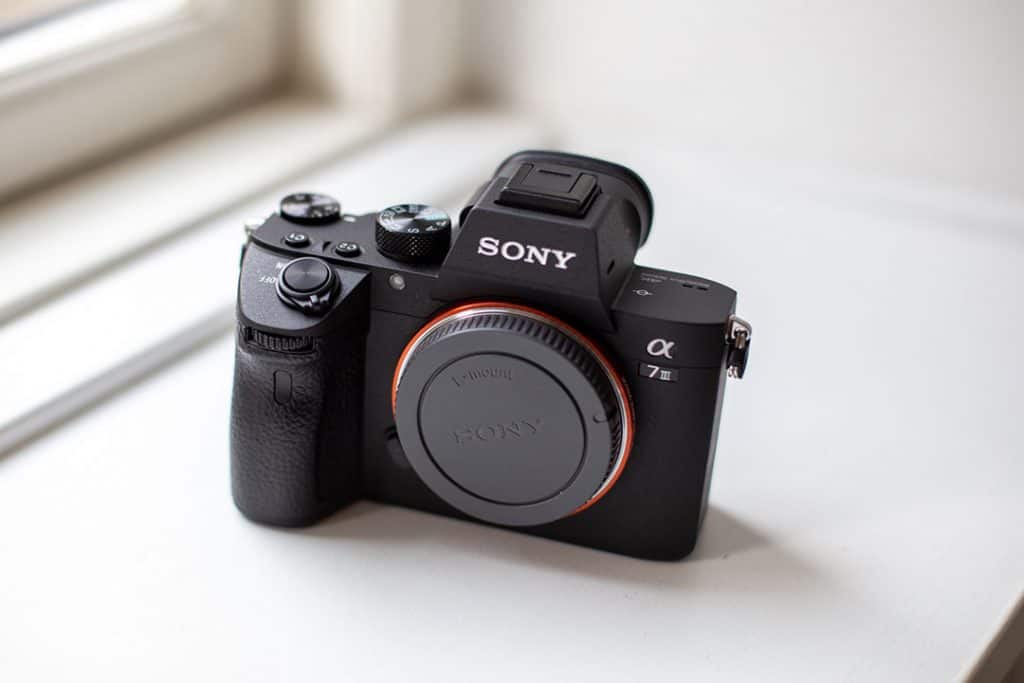
Image stabilization is almost essential in telephoto and macro lenses if the user is to avoid camera-shake.
But the wider the focal length, the less the lens will amplify vibrations.
And by the time you get to wide angle lenses such as those we look at here, image stabilization will be of only limited benefit.
As it is though, few lenses for the Sony a7III offer image stabilization anyway though – as it is available in-camera – so it’s not really an issue that readers need to concern themselves with.
Prime vs Wide Angle Zoom
Zoom lenses are highly convenient. Especially for those photographers who lack legs.
For most other photographers though, a prime lens will usually be the better option.
OK, the above advice is meant somewhat tongue-in-cheek.
Yet there’s a lot of truth to it.
A change of focal length will affect photographic outcomes in a number of ways beyond merely showing more or less of the scene; for a start, it will alter both perspective and depth of field.
That being the case, zooming to a different focal length is not a valid alternative to simply moving closer or further away from the subject.
Yet many inexperienced photographers use their zooms in precisely this manner.
One reason that prime lenses are often a better investment than zooms is simply because they force the user to do the legwork necessary to get a better shot, rather than relying on a lazy change in focal length via a zoom.
More important than this, though, is that a prime lens will generally offer much better optics and faster light-gathering abilities for the money than will a comparable zoom lens.
As zooms are effectively several lenses in one, manufacturers need to pack in a lot more in the way of optics.
Not only does this mean that zooms are invariably bigger than primes, but that shortcuts will often need to be made in terms of construction; frequently resulting in compromised image quality.
With that said, zooms are of course very handy. Especially if you’re the kind of photographer who wants to sling a single A7III camera and lens over your shoulder and just head out to shoot – without being weighed down by any extra baggage.
In this case, be aware that you will likely need to spend a lot more money in order to purchase a zoom lens with maximum aperture and image sharpness comparable to a prime.
And that’s if a comparable option is available at all.
As for avoiding the common trap of zooming when you should merely be taking a step backwards or forwards, well, this ultimately down to the photographer.; if you’ve got the self-control, it needn’t be a problem at all.
Final Thoughts
Sony’s a7III offers pro-level features and stunning image quality for not much more than the cost of a consumer camera.
Where the a7III can become more costly, however, is in purchasing suitable lenses.
And the fact is that high quality wide angles are never the cheapest subcategory of any lens range.
Nonetheless, those happy to go with either a third party offering or a wide angle prime lens from Sony itself will find plenty of suitable options among the current line-up.
And for a little more investment, Sony’s range of pro-level G-Master lenses brings top quality, fast-aperture, wide angle zooms into reach.
With that said, though, there are wide angle lenses, and then there are wide angle lenses.
And precisely which focal length and features you should go for will depend in large part on your specific photographic needs. Still. whatever your requirements, rest assured that all of the options recommended in our guide will be fully up to the rigors of even professional use.
Which one is right for you, only you can decided.
But armed with the information provided in this guide, you should have no problem choosing the best wide angle lens for use with your a7III

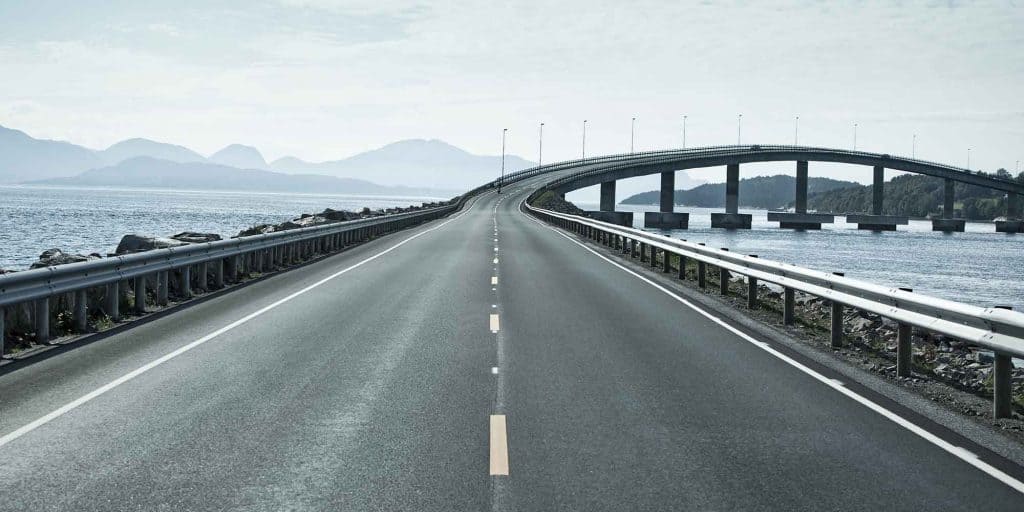
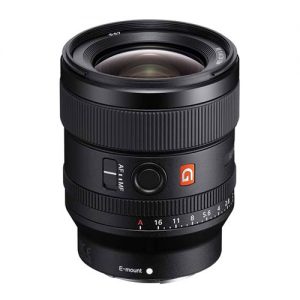
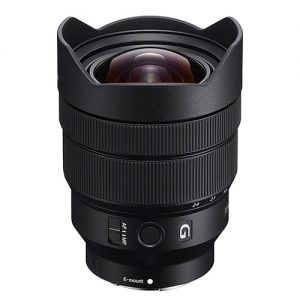
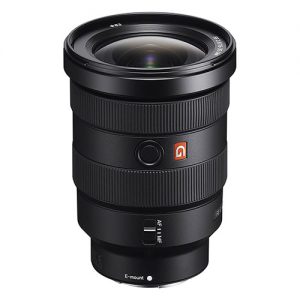
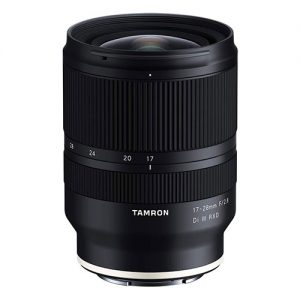
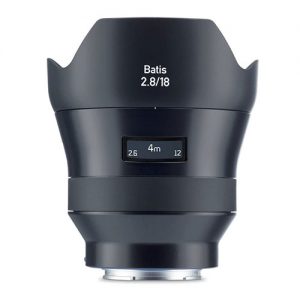
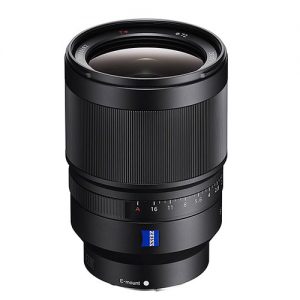
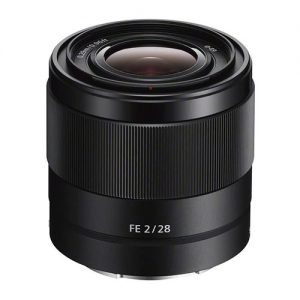


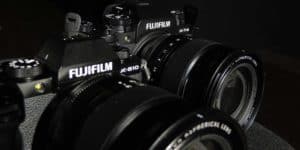
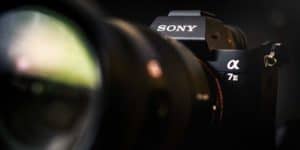
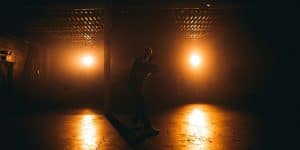
1 thought on “Top 7 Best Wide Angle Lenses for Sony a7III”
Thank you for this post, very useful. Sony Distagon T* FE 35mm F/1.4ZA It’s super sharp and very fast.This model camera I am also using this model. It’s great to feature and a good feature. I have got this model another website this website different model camera.